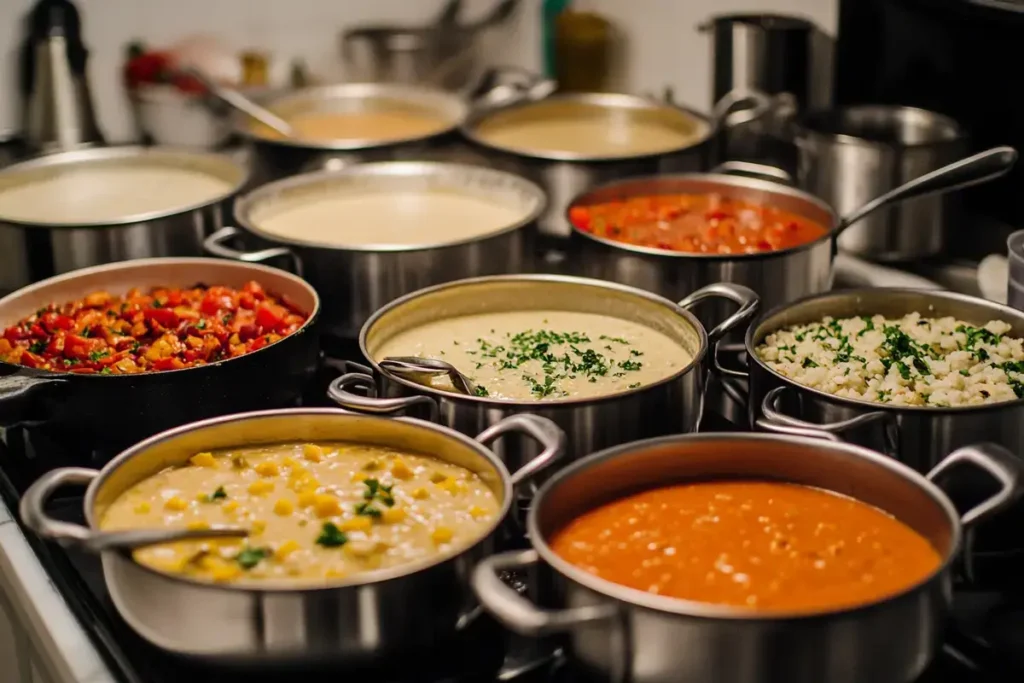Introduction
What makes a soup a bisque vs creamy soup? That question sparks curiosity among culinary enthusiasts everywhere. Bisque has a reputation for luxurious richness, while cream soups evoke comforting warmth. Both feature velvety textures, but they differ significantly in origin, preparation, and flavor profiles. Therefore, understanding these nuances can elevate your cooking skills and impress your guests.
In this article, we will explore bisque’s fascinating history and learn how it evolved into a refined, seafood-based delicacy. We’ll also examine what sets it apart from other cream soups, from thickening techniques to the integral role of shellfish stock. Furthermore, we’ll delve into flavor-building tips and share essential cooking practices. By the end, you’ll have a clear sense of the contrasts between bisque and creamy soup—and pick up five amazing secrets to perfecting both. Let’s dive in.
Understanding What makes a soup a bisque vs creamy soup?
Culinary terminology can be tricky, especially when words like “bisque” and “cream soup” often appear side by side. Before we compare them, let’s clarify some basic definitions. In classical French cuisine, a bisque is a smooth, creamy soup usually made with crustaceans. Often, the shells are roasted and simmered to create a deeply flavored stock. Over time, variations of bisque have emerged, but the core principle remains the same: a delicately blended soup with intense flavor, typically enhanced by cream or other dairy.
Cream soups, on the other hand, are not limited to shellfish. They encompass any soup thickened with a cream base or roux, including classics like cream of mushroom or cream of broccoli. Although they share a similar consistency with bisque, the flavor-building process and key ingredients differ. Therefore, if you’ve ever wondered what makes a soup a bisque vs creamy soup, the answer usually comes down to technique, choice of main ingredients, and the signature shellfish stock in bisque.
Despite these differences, bisque is technically a type of cream soup. However, not all cream soups qualify as bisques. Many bisques rely on the natural thickening power of pureed crustacean shells and cooked vegetables, whereas general cream soups often depend more on flour, cornstarch, or a roux. In addition, bisque’s flavor typically comes from the ocean—shrimp, lobster, crayfish, or crab—giving it a distinct marine essence.

A Brief History of Bisque
Bisque dates back several centuries. Early French cooks developed it to maximize the use of shellfish. The name likely originated from the Bay of Biscay, a coastal region known for abundant seafood. Traditionally, chefs roasted crustacean shells, then ground them into a fine paste. This paste, combined with aromatic vegetables, formed the base of a hearty stew-like creation.
Over time, the method evolved to incorporate blending or pureeing the shells and mirepoix (a mixture of onions, carrots, and celery). Eventually, chefs added cream or thickened milk to enhance the soup’s velvety consistency. By the 17th century, bisque had become an elegant mainstay in royal courts and upper-class dining. It represented both extravagance and resourcefulness.
Although the classical definition of bisque involves seafood, there are modern variants that use tomato or pumpkin as a base. However, the traditional concept still revolves around shellfish. This deep-rooted history explains bisque’s reputation as a refined dish. When people try to understand what makes a soup a bisque vs creamy soup, the storied lineage and exclusivity of ingredients often play a key role.
The Core Components of Bisque
Bisque may seem complicated, but it relies on a few crucial elements:
- Shellfish Stock
The hallmark of a true bisque is a stock made by simmering roasted crustacean shells. This process extracts the full essence of the seafood. Roasting the shells beforehand intensifies flavors, lending a slightly sweet and robust taste. - Aromatic Vegetables
Mirepoix typically includes onions, carrots, and celery. Sometimes, chefs add garlic, leeks, or bell peppers. These vegetables caramelize to add depth and complexity. - Thickening Agent
Classic bisque uses rice or finely ground shells for thickening. Modern recipes may use roux or pureed vegetables. Regardless of method, the soup should maintain a smooth, satiny mouthfeel. - Cream
Most bisque recipes feature cream as a finishing element. Although not always mandatory, dairy adds a luxurious richness that sets bisque apart from other soups.
When you combine these ingredients in the correct proportions, you get a complex blend of sweet, savory, and creamy notes. The careful layering of flavors is key. You don’t simply pour in cream and call it a day. You must develop the foundation slowly, ensuring each stage builds upon the last.
Cream Soups 101
Cream soups offer broad variety. They range from classic chowders to smooth vegetable blends. Typically, you start with a roux or another thickener (cornstarch or pureed potatoes) to create a base. Then you add the main ingredient—whether mushrooms, asparagus, or chicken. Finally, you finish it off with cream, half-and-half, or milk.
Unlike bisque, cream soups don’t rely on shellfish stock for their distinctive flavor. Instead, the taste often hinges on the featured vegetable or protein. For instance, cream of mushroom soup highlights the earthy, umami profile of fungi. Cream of broccoli leans on the subtle pepperiness of this cruciferous veggie. These variations showcase how “cream soup” is more of an umbrella term, encompassing many different ingredients.
Moreover, cream soups typically don’t involve roasting shells or seafood. Instead, cooks simmer vegetables or meats in broth, then incorporate a dairy product. That’s why the question “What makes a soup a bisque vs creamy soup?” usually focuses on shellfish usage and specialized thickening methods.
Secret #1: Layering Aromatics
Both bisque and cream soups benefit from proper aromatic layering. Begin with a base of onions, garlic, and herbs that complement your main ingredient. For bisque, consider adding fennel or leeks to highlight the oceanic flavors. For cream soups, thyme or rosemary can enhance the heartiness of vegetables. This layering approach allows flavors to meld over time, creating a more cohesive taste.
Short, controlled sautéing of aromatics in butter or oil extracts the essential oils. Keep the heat moderate. A gentle cooking process ensures that onions soften without charring, and herbs release their fragrance gracefully. An under-sautéed base can yield a flat-tasting soup, while over-browning could introduce bitterness. When done right, layering aromatics elevates a soup from ordinary to exceptional.
Secret #2: The Power of Stock
Stock forms the backbone of many soups. For bisque, using a homemade shellfish stock is crucial. Don’t shortcut this step if you desire authentic flavor. Roasting shrimp or lobster shells in the oven until they turn orange-brown coaxes out sweet, briny notes. Then simmer them in water with chopped onions, carrots, and celery. Skim any foam that surfaces to keep the stock clear.
For cream soups, chicken or vegetable broth often works best. Store-bought versions are convenient, but homemade stock can provide a deeper dimension. However, not all cream soups require stock. In some cases—like a cream of potato soup—you can use just water, relying on the potatoes themselves for body. Choose a stock that complements the dominant ingredient. For example, vegetable stock for broccoli soup, or chicken stock for cream of chicken soup.
Secret #3: Proper Thickening Methods
Thickening transforms a watery mixture into a luxurious, spoon-coating delight. In bisque, this is often accomplished by pureeing the shells or incorporating cooked rice. The starch naturally binds the soup, leaving a velvety finish. Many modern bisque recipes do call for flour-based roux, but purists argue that ground shells or rice maintain a more authentic taste.
By contrast, cream soups commonly employ roux, cornstarch, or simply blending the main vegetable. A cream of cauliflower soup, for instance, relies heavily on the pureed cauliflower to achieve thickness. Cream soups also tend to be less reliant on the intense layering from seafood stock. Instead, the star ingredient—be it potato, mushroom, or corn—shines through, supported by the creaminess.
Secret #4: Seasoning at the Right Stages
Seasoning is not just about salt and pepper. It involves carefully timing additions of herbs, spices, and acids. For bisque, you often incorporate a splash of brandy or sherry to intensify flavors. This addition typically comes toward the end of cooking, allowing the alcohol to evaporate and the sweet, nutty undertones to linger.
Cream soups might need a dash of lemon juice or white wine vinegar to brighten their taste, especially if the primary ingredient is mild. The tanginess can counterbalance the richness of cream, preventing the soup from feeling heavy. Always remember to taste frequently. You can adjust salt or acidity in small increments to find that perfect balance.
Secret #5: Finishing Touches
The final flourish can make or break both bisque and cream soups. A drizzle of extra virgin olive oil or a swirl of cream can add an elegant look. Chopped chives or parsley provide a fresh contrast in color and flavor. For seafood bisque, a garnish of lobster meat or shrimp tail is both decorative and delicious.
In cream soups, toppings like shredded cheese, crispy bacon bits, or croutons introduce texture and visual appeal. Fresh herbs sprinkled on top hint at the flavors within. Serving your creation in a warm bowl ensures it stays hot and inviting. Whether you’re showcasing a delicate shrimp bisque or a hearty cream of mushroom, thoughtful garnishes elevate the soup to a restaurant-quality experience.

Bisque Variations Around the World
While French cuisine popularized bisque, many cultures feature a similar style of rich, seafood-based soups. In parts of Asia, soups thickened with coconut milk or rice can resemble bisque, especially when shellfish is central. In the Caribbean, bisque-like stews incorporate local spices and peppers for a fiery twist. Spanish cuisine offers caldo de mariscos—a seafood soup often thickened with bread—which parallels the concept of bisque but with a different flavor profile.
These global takes illustrate the versatility of “What makes a soup a bisque vs creamy soup?” The fundamental techniques remain: extracting flavors from shells or bones, blending ingredients, and creating a silky consistency. Regional touches like lemongrass or scotch bonnet chilies make each version unique. They also reveal how culinary traditions borrow and adapt from one another across continents.
Common Misconceptions
Many people assume that any thick, creamy soup containing seafood qualifies as a bisque. However, clam chowder, for example, is not a bisque. Chowder typically includes chunks of potatoes, celery, and onions, plus bacon for extra flavor. It does not require blending everything into a smooth puree. Bisque, on the other hand, must be velvety, with little to no solid pieces.
Another misconception is that bisques are always pink or orange. While many are, due to the color of shrimp or lobster shells, some variants may appear more reddish or even pale if they use lighter shellfish or different vegetables. Ultimately, the color depends on the shellfish variety, additional ingredients, and how thoroughly everything is blended.
Crafting the Perfect Homemade Bisque
If you’re ready to try making bisque at home, here’s a brief overview:
- Roast the Shells
Spread shrimp or lobster shells on a baking sheet. Drizzle with a small amount of oil and roast in the oven until the shells are fragrant and lightly browned. - Build the Stock
Transfer roasted shells to a pot. Add onions, carrots, celery, and enough water to cover. Simmer gently for at least 30 minutes, skimming off any foam. - Sauté Aromatics
In a separate pan, sauté onions, garlic, and any other desired vegetables in butter. Once translucent, add tomato paste (if using) for extra depth. - Combine and Blend
Strain the shellfish stock into the pan with sautéed aromatics. Add cooked rice or your preferred thickener. Simmer until flavors merge. Puree using a blender or immersion blender. - Finish with Cream
Stir in cream to taste. Season with salt, pepper, and a splash of brandy or dry sherry. Adjust thickness by adding more stock or cooking longer. Garnish lavishly and serve hot.
This step-by-step approach demystifies the bisque-making process. The key is patience and layering flavors at each stage. By the time your bisque is done, the rich, seafood-forward aroma should fill your kitchen, enticing everyone to have a taste.
Cream Soup Essentials: Quick Guide
While making a bisque typically involves several steps, cream soups can be simpler:
- Choose Your Main Ingredient
Pick a vegetable or protein you love—broccoli, chicken, mushrooms, or corn. - Sauté a Base
Cook onions, garlic, or leeks in a bit of butter or oil to start building flavor. - Add Broth and Simmer
Pour in chicken or vegetable stock and simmer until the main ingredient is tender. - Thicken and Blend
Stir in a roux, cornstarch slurry, or puree some (or all) of the soup’s contents. This creates the desired thickness. - Incorporate Cream
Reduce heat to low. Stir in cream, milk, or half-and-half. Season gradually with salt, pepper, and herbs. Adjust the final thickness if needed. - Garnish
Sprinkle fresh herbs, cheese, or croutons on top for a finishing flourish.
This straightforward approach explains why cream soups are so popular in home kitchens. They’re budget-friendly, adaptable, and quick to prepare. The main difference from a bisque is the absence of shellfish stock and the specialized thickening steps.
Comparing Nutrition
Both bisque and cream soups have a reputation for richness. However, nutritional content depends on portion size and specific ingredients. Bisque often contains higher cholesterol due to shellfish and cream. It can also be relatively high in sodium if you use salted stocks. Cream soups can vary widely. A potato-based soup might have fewer calories than a cream of bacon soup, for example. Still, the presence of heavy cream or cheese adds fat.
For a lighter version, you can reduce the amount of cream or use low-fat milk. You can also experiment with pureed vegetables as a natural thickener. For instance, pureed cauliflower can mimic the texture of cream, cutting back on dairy while maintaining a silky feel. Always read labels if using store-bought broth, and consider homemade options for better control over sodium and additives.

Cultural Significance and Serving Suggestions
Bisque is often associated with special occasions or fine dining. Restaurants sometimes serve it in smaller portions as a starter course, garnished with lobster or shrimp. The dish’s elegance and labor-intensive preparation make it a celebratory choice. Cream soups, on the other hand, span various cuisines and social settings. A hearty cream of chicken soup might appear at a family dinner, while cream of mushroom could be a comforting lunch option.
Serving suggestions vary. Bisque pairs wonderfully with crusty bread, allowing you to soak up every drop of the aromatic liquid. You can also serve it alongside a fresh green salad for textural contrast. Cream soups go well with sandwiches, crackers, or simple side salads. Their versatility and mild flavors make them a frequent companion to other dishes. Whichever soup you choose, consider the context—are you hosting a formal dinner or enjoying a casual weeknight meal?
Troubleshooting Common Issues
Even experienced cooks run into soup-related snafus. Here are a few tips:
- Too Thick or Thin
If your bisque or cream soup is too thick, gradually add more stock or water. If it’s too thin, simmer uncovered to reduce liquid or whisk in a small amount of roux. - Overly Salty
You can try adding extra unsalted broth or water to dilute the saltiness. A splash of acid (lemon juice or vinegar) sometimes helps balance flavors, but proceed carefully. You don’t want to make the soup sour. - Curdled Cream
High heat can cause cream to curdle. Always reduce the heat to low before adding dairy. Stir gently and steadily to integrate the cream. - Off Color
Don’t worry if your bisque isn’t a perfect pink-orange hue. Different shellfish or vegetable combos can change the color. Focus on taste and texture instead.
Final Thoughts on Bisque vs Cream Soup
When asking “What makes a soup a bisque vs creamy soup?” remember that bisque hinges on shellfish stock, roasted shells, and a particular thickening technique—often ground shells or rice. Cream soups, while similarly smooth, rely on a broader range of main ingredients and thickening methods like roux or pureed vegetables. Both are delicious, comforting, and versatile in their own ways.
By mastering the five amazing secrets—layering aromatics, choosing the right stock, proper thickening, strategic seasoning, and finishing touches—you’ll consistently create satisfying bowls of bisque or cream soup. Whether you’re celebrating a special occasion or whipping up a simple meal, these soups can become a highlight on your menu. Experiment with different flavors, trust your taste buds, and soon you’ll feel confident making either style.
FAQ
What makes a soup into a bisque?
A bisque typically involves a base made from roasted shellfish shells, which is then simmered to create a concentrated stock. The liquid is thickened—often using rice or pureed shells—and blended to achieve a velvety texture. Cream is commonly added for richness.
What is the difference between cream soup and bisque?
Cream soup is a broad category of soups thickened with dairy, roux, or pureed vegetables. Bisque, however, almost always includes shellfish stock derived from crustaceans like shrimp or lobster. That seafood foundation sets it apart from standard cream soups.
What are the two ingredients that make a bisque different from a puree soup?
Shellfish stock and roasted shells typically distinguish a bisque from other pureed soups. These elements give bisque its signature marine flavor and rich depth. Puree soups generally rely on vegetables or other proteins and may not involve seafood at all.
What makes a dish a bisque?
A dish is considered a bisque when it contains a robust shellfish stock, a smooth, blended consistency, and a creamy component. Classic bisques use crustacean shells and simmer them extensively, capturing intense seafood flavors before pureeing and finishing with cream.

